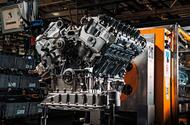The Unshakable W12: Bentley’s Legendary Engine Comes to an End

After years of captivating car enthusiasts, Bentley has officially ceased production of their iconic W12 engine. This marks the end of a chapter in our love affair with 12-cylinder engines. Hand-built with 2600 parts, each W12 engine was meticulously crafted in just seven hours.
Once installed and ignited, the 6.0-liter, twin-turbocharged powerhouse propelled the Bentley Continental GT to an astonishing top speed of 208mph.
The W12 engine underwent a three-year redevelopment process to meet the demands of the 2015 Bentley Bentayga. It was equipped with faster-responding twin scroll turbos and cylinder deactivation on one bank of six, resulting in reduced fuel consumption when the driver lifts or trails the throttle. Additionally, it was tested to perform at tilt angles of up to 35 degrees, making it suitable for an SUV.
The Allure of the V12 Engine
The enduring appeal of 12-cylinder engines lies in their refinement and power. Many car manufacturers have chosen V12 engines for their smoothness and performance. Bentley, however, took a slightly different approach by utilizing a W12 engine, which shares similarities with the V12 but with a subtle yet significant tweak.
Engine Balance: The Key to Smoothness
The smoothness of an engine is determined by its vibrations. Primary balance refers to vibrations that occur at every revolution of the engine, while secondary balance occurs every two revolutions. Reciprocating masses (the weight of internal parts moving vertically or horizontally) and rotating masses, such as the crankshaft and combustion forces, contribute to these vibrations. Other factors, including the cylinder firing order and the precise weight of reciprocating parts, also affect engine balance.
Straight-six engines are known for their perfect balance, thanks to the orchestrated movement of their pistons. Similarly, a V12 engine with two banks of six cylinders should also exhibit perfect balance. The W12 engine follows this principle but with a twist. The cylinders in each bank are offset by 15 degrees, allowing them to be closer together and making the engine 24% shorter. Despite having only two banks of cylinders, the W12 engine is as smooth as a conventional V12, passing the “coin test” where a coin can stand unaided on its surface at idle.
The W12 engine owes its refinement not only to its unique design but also to the meticulous hand-building process. Pistons and conrods are carefully sorted into balanced sets, ensuring they weigh within fractions of a gram.
Although the production of Bentley’s W12 engine has come to an end, its legacy as a symbol of power, refinement, and engineering excellence will continue to captivate car enthusiasts for years to come.

